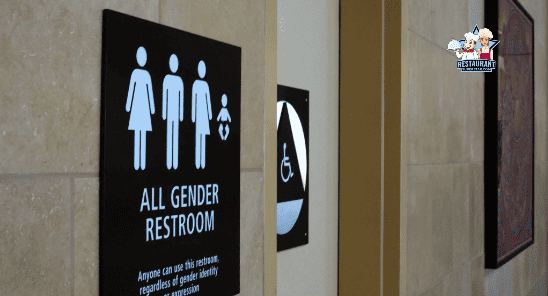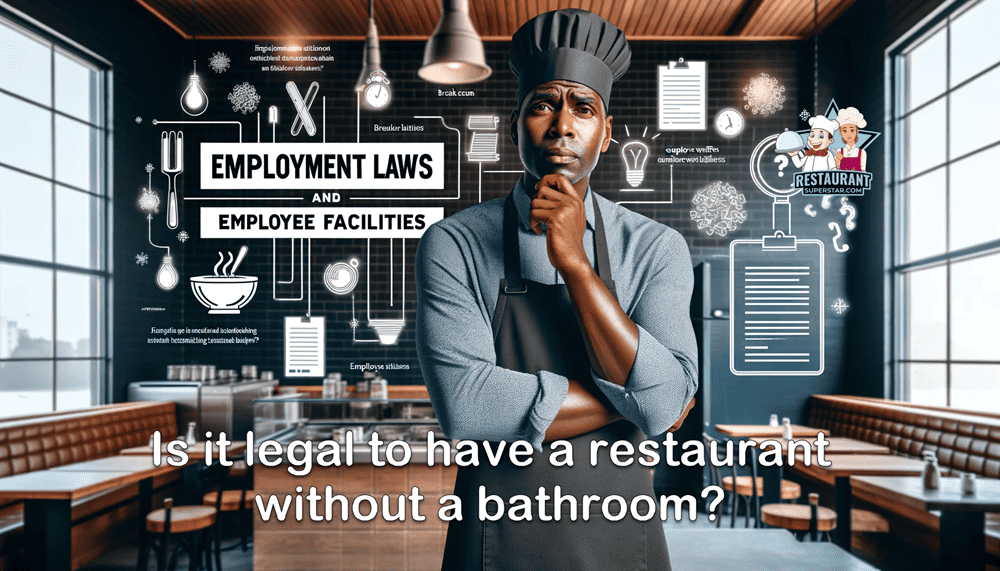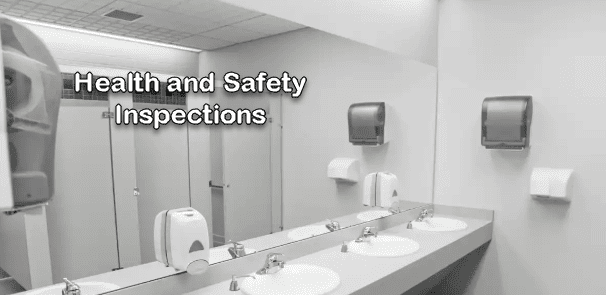Is it legal to have a restaurant without a bathroom?
You are in the right place if you’re wondering, “Is it legal to have a restaurant without a bathroom?” This article will delve deep into this pressing query, uncovering the straightforward answer and navigating the intricate regulations surrounding this topic.
If you’re a new restaurant owner, a young chef, or simply curious about the legalities of restaurant facilities, keep reading for valuable insights.
Is it legal to have a restaurant without a bathroom?
Is it legal to have a restaurant without a bathroom? The short answer is: it depends. The legality of operating a restaurant without a bathroom hinges on various factors, including the number of seats, the year of establishment, and specific local laws.
While in some cases, such as small eateries or establishments offering only takeout, the absence of a restroom might be legally acceptable, in others, it’s a clear violation of regulations.
For instance, in New York City, any restaurant with more than 20 seats is required to provide a bathroom.
Yet, that’s just the tip of the iceberg.
Now that you have a basic understanding, it’s time to dive deeper.
This article will explore everything you need to know about the question, “Is it legal to have a restaurant without a bathroom?” We’ll unravel the complexities of different jurisdictions, discuss exceptions, and provide critical insights for new restaurant owners and chefs.
Stay tuned to discover how these regulations affect your culinary venture and learn what it takes to stay compliant and customer-friendly in the dynamic world of food service.
Gaining a comprehensive understanding of this subject is paramount, particularly if you aspire to establish or operate your restaurant.
Here’s why:
- Compliance is key. Navigating the legal landscape is essential for any business, and restaurants are no exception. Knowing whether your restaurant needs a bathroom is not just about customer convenience; it’s a legal requirement in many places.
- Local Laws Matter: The rules can vary widely depending on your location. What’s okay in one city might be a no-go in another. Staying informed about local health codes and building regulations is a must.
- Future-Proofing Your Business: Understanding these regulations from the start helps you avoid costly renovations or legal troubles. It’s all about being proactive rather than reactive.
- Customer Experience: Even if it’s not legally required, providing a bathroom can significantly enhance your customers’ dining experience. It’s a part of the hospitality that guests appreciate.
So, whether you’re dreaming up a cozy café, a bustling restaurant, or a takeaway joint, knowing the answer to “Is it legal to have a restaurant without a bathroom?” is fundamental.
Please stick with us as we delve into this topic. We promise to keep it simple, straightforward, and super informative.
Key Factors Influencing the Legality of Restaurants Without Bathrooms

Seating Capacity and Bathroom Requirements
When answering the question, “Is it legal to have a restaurant without a bathroom?” One of the critical factors is the seating capacity of your establishment.
Here’s the lowdown:
- The Magic Number: In many areas, the number of seats you have determines your restroom obligations. For instance, the rule of thumb in New York City is 20 seats. You must provide restroom facilities if your restaurant seats 20 or more customers. Less than that, and you might be off the hook.
- Why It Matters: The logic here is pretty straightforward. More seats mean more customers, and more customers suggest a higher need for restrooms. It’s all about ensuring comfort and convenience for the folks who dine in your restaurant.
Impact of Opening Year on Bathroom Requirements
This is an exciting twist: the year your restaurant opened can determine whether you need to provide bathrooms.
Let’s break it down:
- A Look Back in Time: In some jurisdictions, older restaurants might get a pass on current restroom requirements. For example, back to New York City: if your restaurant opened its doors before 1977 and has less than 20 seats, you might not need to worry about adding a bathroom.
- Why This Is a Thing: It’s a way of balancing historical preservation with modern regulations. Retrofitting old buildings with new facilities can be challenging, so this consideration helps preserve the charm and heritage of vintage establishments.
Suppose you’re a new restaurant owner or a chef dreaming up your next culinary venture. In that case, it’s crucial to understand these two factors.
The number of seats in your restaurant and the year it opened can significantly impact your legal obligations regarding restroom facilities.
Always check with your local health department or regulatory agencies to ensure you’re clear and provide the best experience for your guests.
Specific Exceptions and Considerations
When pondering, “Is having a restaurant without a bathroom legal?” Consider some exceptions and unique scenarios that might apply to your establishment.
Proximity to Public Restrooms
Let’s talk about how being near a public restroom can impact your bathroom obligations.
- Close Neighbors: In some jurisdictions, if your restaurant is a hop, skip, and jump away from public restroom facilities, you might not need one on-site. It’s like having a shared amenity with the community.
- How Close is Close Enough?: This can vary. Some places might have a specific distance measurement, like within 500 feet of a public restroom. Others might be more about practical accessibility.
- The Catch: Just because there’s a public restroom nearby doesn’t automatically exempt you. You’ll need to check with local health and building codes to see if this exception applies to your restaurant.
Takeout and Delivery-Only Services
Now, this is a game-changer for the small and mighty takeout joints:
- No Seats, No Problem: The need for a customer bathroom often disappears for restaurants that exclusively offer takeout and delivery services without any dine-in option. After all, if no one’s sitting down to eat, the demand for a restroom decreases significantly.
It’s a relief for many small business owners who operate out of compact spaces or focus solely on food production without a dining area.
It’s all about matching facilities to the services offered.
So, whether you’re running a cozy café next to a public park with facilities or a bustling pizza takeout joint, these exceptions could be a game-changer.
Remember the golden rule: always double-check with your local regulatory bodies to ensure you’re compliant and good to go.
Legal and Regulatory Landscape
Understanding the legalities of whether “Is it legal to have a restaurant without a bathroom?” requires navigating the diverse terrain of federal, state, and local laws and considering the type of food service and accessibility requirements.
Variations in Federal, State, and Local Laws
- No Federal Mandate: There needs to be an overarching federal law in the United States that dictates the need for restaurant bathrooms. This means the responsibility falls on state and local jurisdictions.
- A Patchwork of Regulations: Each state, and often each city, has its own set of rules. What might be a strict requirement in one area could be a relaxed guideline in another. This variability means restaurant owners must be well-versed in local health codes and building regulations.
- Keeping Up with Changes: Laws and regulations can evolve, so staying informed about any updates or changes in your area is crucial for compliance and smooth operation.
Restaurant Type and Food Service
- Diverse Dining Experiences: The type of restaurant you run can significantly influence restroom requirements. For instance, a fine dining establishment might have different obligations than a fast-food joint.
- Exceptional Cases Like Liquor Service: If your restaurant serves alcohol, there might be additional requirements. Many places require establishments serving liquor to provide restroom facilities, given the nature of the service and customer needs.
Accessibility and Disability Compliance
- Inclusivity is key. Ensuring that restrooms are accessible to people with disabilities isn’t just good practice; it’s often a legal requirement under laws like the Americans with Disabilities Act (ADA).
- Design Considerations: Consider factors like wheelchair accessibility, grab bars, and appropriate signage. Accessible facilities ensure everyone has a comfortable and dignified experience at your restaurant.
Navigating restaurant bathrooms’ legal and regulatory landscape is like piecing together a puzzle.
Whether it’s understanding local laws, catering to different restaurant types, or ensuring accessibility, each piece is vital for the complete picture.
And remember, while the specifics might vary, the goal is always to create a welcoming and compliant space for your guests.
Employment Laws and Employee Facilities

When considering the question, “Is it legal to have a restaurant without a bathroom?” It’s not just about customer convenience; employee needs are equally important. Let’s dive into the legal landscape surrounding restroom requirements for your staff.
Restroom Requirements for Employees
- A Basic Right: Providing employee restroom facilities is fundamental to employment laws in many jurisdictions. It’s about ensuring your workforce’s health, safety, and dignity.
- OSHA Standards: In the United States, employers must ensure they provide restroom facilities for their employees, as required by the Occupational Safety and Health Administration (OSHA). This rule is all about keeping the workforce safe and sound. This regulation applies to all establishments, regardless of size or the nature of the services provided.
- Not Just Any Restroom: These facilities must be sanitary and accessible during working hours. It’s not just about ticking a box; it’s about providing your staff with a clean, safe, and private space.
- Alternatives for Small Spaces: What if your restaurant is too small to accommodate a restroom? Some localities allow for arrangements where employees can access nearby restroom facilities. However, this is subject to specific conditions, like proximity and accessibility.
- Keeping Up with Regulations: As with customer bathrooms, the rules for employee restrooms can vary based on local and state laws. Staying informed and compliant ensures your restaurant’s smooth, legal operation.
While the focus is often on customer facilities, employee restroom requirements are critical to running a restaurant.
Ensuring your staff has access to proper restroom facilities is not just a legal obligation; it’s a sign of respect and care for your team.
Remember, a happy and healthy workforce is critical to a successful restaurant.
The Importance of Restrooms in Restaurants
While understanding the legalities of “Is it legal to have a restaurant without a bathroom?” is crucial, it’s equally important to recognize the impact of restrooms on customer satisfaction and health inspections. Here’s how:
Customer Satisfaction and Experience
- More Than Just a Convenience: Restrooms in a restaurant aren’t just about meeting a legal requirement – they play a big role in enhancing customer experience and satisfaction, you know? A clean, well-maintained restroom reflects your establishment’s hygiene and attention to detail.
- A Factor in Reviews: In the current digital landscape, where online reviews can shape a business’s fate, let’s discuss the condition of your restroom facilities. They can be a real talking point, you know? Positive restroom experiences often translate into better reviews and more customers.
- Customer Comfort: Restrooms become essential to overall comfort and convenience, especially in establishments where customers spend considerable time, like cafes or dine-in restaurants.
Health and Safety Inspections

- A Checklist Item: During health and safety inspections, restrooms are often on the checklist. Inspectors look for cleanliness, sanitation, and proper maintenance.
- Compliance with Hygiene Standards: The presence and condition of restrooms can significantly impact your restaurant’s ability to pass health inspections. Restrooms not up to the mark can lead to penalties or temporary closure.
- An Indicator of Overall Hygiene: Well-kept restrooms often indicate a high standard of overall hygiene in the restaurant, which inspectors take as a positive sign of good management and operational practices.
Restrooms are more than just a legal necessity; they are a crucial element of the customer experience and play a vital role in maintaining health standards.
As a restaurant owner or chef, investing time and resources into ensuring your restroom facilities are top-notch is a wise and beneficial decision.
Frequently Asked Questions
Are US restaurants required to have bathrooms?
Yes, in the United States, restaurants are legally required to have bathrooms. This is due to the Americans with Disabilities Act (ADA), which ensures accessibility for individuals with disabilities in all public areas, including restaurants. The ADA’s mandates are designed to prevent discrimination based on disability in public accommodations.
What is the New York State Restroom Access Act?
The New York State Restroom Access Act is legislation that provides access to employee-only toilet facilities in businesses open to the public for individuals with specific medical conditions, particularly gastrointestinal diseases. This act aims to create a compassionate and accommodating environment for those who suffer from such conditions.
What states have the Restroom Access Act?
As of January 2023, at least 18 states in the United States have enacted versions of the Restroom Access Act. These states include California, Colorado, Connecticut, Arkansas, Illinois, Kentucky, Louisiana, Maryland, Massachusetts, Michigan, Minnesota, New Hampshire, New York, Ohio, Oregon, Tennessee, Texas, Wisconsin, and Washington. The act is a significant step towards accommodating individuals with specific health needs.
Could you eat at every restaurant in NYC?
Eating at every restaurant in New York City is virtually impossible. NYC is home to approximately 24,000 restaurants, and the dining scene is constantly changing with new openings and closures. Even if one were to eat three different meals at different restaurants every day, it would take many years to cover them all, by which time the landscape of restaurants would have significantly changed.
Conclusion
In wrapping up our exploration of the question, “Is it legal to have a restaurant without a bathroom?” it’s clear that the answer isn’t just a simple ‘yes’ or ‘no.’ It’s a multifaceted issue that hinges on understanding and adhering to local laws and regulations.
- Local LawsGovern: The most important aspect is recognizing that local regulations are essential. Whether based on seating capacity, the year your restaurant opened, or other specific conditions like proximity to public restrooms or the nature of your service (dine-in vs. takeout), compliance with local laws is non-negotiable.
- Beyond Legal Compliance: Providing restrooms in your restaurant, whenever possible, isn’t just about legality. It enhances customer experience, contributes to positive reviews, and reflects well in health inspections. It’s an investment in your business’s reputation and customer satisfaction.
- Employee Considerations: Remember your staff. Ensuring employees have access to clean and safe restrooms is not just a legal requirement but an essential aspect of workplace welfare.
- Stay Informed and Updated: Laws and regulations can change, so keeping yourself updated is crucial for ongoing compliance and success.
- When in doubt, consult the experts: Each restaurant’s situation is unique; sometimes, navigating the legalities can be complex. If you’re ever in doubt, seeking advice from legal experts in your area is a wise step. They can provide tailored advice to ensure your restaurant meets all requirements.
Understanding the ins and outs of restaurant restroom requirements is more than just ticking a box for legal compliance; it’s about being a responsible and savvy business owner.
Stay informed and compliant, and you’ll be well on your way to creating a welcoming and successful restaurant.
Jeff Smith is a Restaurant Consultant with over 20 years of hospitality experience ranging from server to owner and general manager. He focuses on Restaurant POS technology as well as restaurant marketing. Check out our world-famous restaurant resources page for a comprehensive offering of hand-picked resources and tools to help your business. You can also check out some of our other restaurant business articles.



